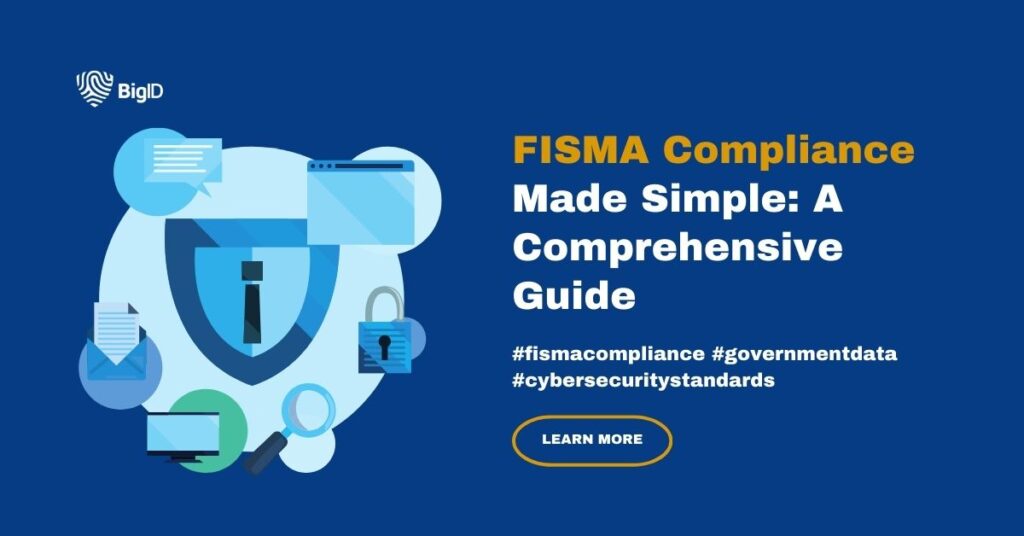FISMA Compliance Made Simple: A Comprehensive Guide

With the landscape of data privacy and security changing every day, maintaining compliance with regulatory frameworks is paramount. For data privacy leaders and Chief Privacy Officers (CPOs), understanding the intricacies of the Federal Information Security Management Act (FISMA) is essential. This guide explores the meaning, restrictions, exemptions, violations, and requirements associated with FISMA compliance. Additionally, we detail how companies can establish and maintain compliance, including a detailed FISMA compliance checklist. Join us as we navigate the complexities of FISMA and its significance in today’s digital age.
Unlocking the Essence of FISMA Compliance
FISMA— often referred to as the cornerstone of federal cybersecurity— mandates stringent measures to safeguard federal information systems and data. Understanding what FISMA compliance entails is the first step towards building a robust security posture.
What is FISMA Compliance?
FISMA compliance involves adhering to a set of guidelines and standards established by the National Institute of Standards and Technology (NIST) to protect the confidentiality, integrity, and availability of federal information and systems.
Key components of FISMA compliance include:
- Conducting risk assessments and implementing appropriate security controls.
- Developing and maintaining a system security plan (SSP) outlining security policies and procedures.
- Performing security assessments and continuous monitoring to ensure compliance.
- Reporting security incidents and breaches in accordance with established protocols.
Benefits of FISMA Compliance
FISMA, the Federal Information Security Management Act, establishes a comprehensive framework to protect government information, operations, and assets against cybersecurity threats. Compliance with FISMA offers several benefits:
- Enhanced Security Posture: FISMA compliance mandates the implementation of robust security measures, which helps organizations strengthen their overall security posture. This reduces the risk of cyber attacks and data breaches.
- Risk Management: FISMA requires organizations to conduct security assessments and develop risk management strategies. By identifying and mitigating security risks, organizations can better protect sensitive information and critical assets.
- Legal and Regulatory Compliance: FISMA compliance ensures adherence to legal and regulatory requirements for federal networks and data. This is essential for government agencies and organizations that work with government entities to avoid legal penalties and fines.
- Improved Data Protection: FISMA compliance helps organizations implement measures to protect sensitive and confidential data. This includes encryption, access controls, and data loss prevention mechanisms, which safeguard information from unauthorized access and disclosure.
- Enhanced Trust and Reputation: Demonstrating FISMA compliance signals to stakeholders, including government agencies, partners, and customers, that an organization takes cybersecurity seriously. This enhances trust and confidence in the organization’s ability to safeguard sensitive information.
- Operational Efficiency: FISMA compliance requires the establishment of standardized processes and procedures for managing information security. This leads to improved operational efficiency, as organizations have clear guidelines for handling security-related tasks and incidents.
- Cost Savings: While the initial investment in achieving FISMA compliance may be significant, it can result in long-term cost savings by reducing the likelihood of security breaches and their associated financial and reputational consequences.
- Access to Government Contracts: FISMA compliance is often a prerequisite for government contracts involving the handling of sensitive information. By achieving compliance, organizations can access a broader range of opportunities and contracts within the government sector.
Overall, FISMA compliance is essential for organizations operating within or alongside the federal government to ensure the security and integrity of all systems and data. It offers numerous benefits, ranging from improved security posture and regulatory compliance to enhanced trust and operational efficiency.
FISMA Compliance Violations & Penalties
Failure to comply with FISMA requirements can lead to various penalties and consequences, including:
- Financial Penalties: Non-compliance with FISMA may result in financial penalties imposed by regulatory agencies or government bodies. These penalties can vary depending on the severity of the violation and may include fines or other monetary sanctions.
- Loss of Contracts: Organizations that fail to meet FISMA compliance requirements may lose existing government contracts or be disqualified from bidding on future contracts that involve the handling of sensitive information or government data.
- Legal Liability: Non-compliance with FISMA may expose organizations to legal liability, including lawsuits from affected individuals, government agencies, or regulatory authorities. This can result in significant legal expenses, damages, and reputational harm.
- Reputational Damage: Failing to comply with FISMA can damage an organization’s reputation and credibility, particularly if there are publicized security breaches or data incidents. This can lead to loss of customer trust, negative media coverage, and long-term harm to the organization’s brand.
- Loss of Government Funding: Government agencies and organizations that receive federal funding may face repercussions for non-compliance with FISMA, including the potential loss of funding or grants allocated for information technology projects or initiatives.
- Increased Oversight and Audits: Non-compliant organizations may be subject to increased scrutiny, audits, and regulatory oversight by government agencies responsible for enforcing FISMA requirements. This can lead to additional administrative burdens, costs, and potential disruptions to business operations.
- Remediation Costs: In addition to potential fines and penalties, organizations may incur significant costs to remediate security vulnerabilities, implement necessary protection, and address deficiencies identified during audits or assessments.
Overall, the penalties for non-compliance with FISMA can have serious financial, legal, and reputational consequences for organizations. It is essential for entities subject to FISMA regulations to prioritize compliance efforts to avoid these penalties and ensure the security and integrity of federal information databases.
Deciphering FISMA Requirements
FISMA outlines specific requirements that federal agencies and their contractors must meet to ensure the security of sensitive information. These requirements encompass various aspects of information security, including access control, risk management, and incident response. FISMA requirements include:
- Risk Assessment: Organizations must identify and assess risks to their information systems, including threats, vulnerabilities, and potential impacts.
- Security Controls: FISMA requires implementing a set of security controls to protect information systems and data. These controls address various aspects of cybersecurity, such as access control, encryption, and incident response.
- System Security Plan (SSP): Organizations must develop and maintain a System Security Plan (SSP) that documents security policies, procedures, and controls for each information system.
- Security Assessment and Authorization (SA&A): FISMA mandates conducting security assessments to verify compliance with security controls and authorize the operation of information systems based on risk.
- Continuous Monitoring: Organizations must continuously monitor their information systems to detect and respond to security incidents, assess the effectiveness of security controls, and maintain situational awareness of cybersecurity risks.
- Incident Response: FISMA requires establishing incident response procedures to promptly detect, report, and respond to security incidents, breaches, or vulnerabilities.
- Training and Awareness: Employees and contractors with access to federal information systems must receive training on security policies, procedures, and their responsibilities for safeguarding sensitive information.
- Reporting Requirements: Organizations must report security incidents, breaches, and vulnerabilities to appropriate authorities, including the Department of Homeland Security (DHS) and the Office of Management and Budget (OMB).
Who Must Comply
FISMA, the Federal Information Security Management Act, applies to federal agencies and their contractors who handle sensitive information on behalf of the government. This includes:
- Federal Agencies: All executive branch departments, agencies, and offices of the U.S. government must comply with FISMA requirements to secure their information systems and protect sensitive data.
- Contractors: Organizations and individuals contracted by federal agencies to provide goods or services involving federal information systems are also subject to FISMA compliance requirements.
Federal agencies that are most vulnerable to FISMA compliance include those handling highly sensitive information, such as:
- Department of Defense (DoD): Responsible for national defense and military operations, DoD agencies must comply with strict security standards to protect classified information and critical infrastructure.
- Department of Homeland Security (DHS): Charged with safeguarding the nation from various threats, including cybersecurity risks, DHS agencies are vulnerable to FISMA compliance due to their role in protecting critical infrastructure and coordinating national security efforts.
- Department of Justice (DOJ): Responsible for enforcing federal laws and administering justice, DOJ agencies handle sensitive legal and law enforcement data, making them targets for cyber threats and requiring stringent FISMA compliance measures.
- Department of Health and Human Services (HHS): Oversees public health, healthcare, and social services programs, HHS agencies manage vast amounts of sensitive healthcare data, making them susceptible to data breaches and necessitating robust FISMA compliance efforts to protect patient privacy and confidentiality.
- Department of State: Manages U.S. foreign policy and diplomacy, the Department of State handles sensitive diplomatic communications and classified information, requiring comprehensive FISMA compliance measures to safeguard national security interests.
These federal agencies, along with their contractors, must prioritize FISMA compliance to mitigate cybersecurity risks, protect sensitive information, and maintain the integrity of government operations.

Navigating FISMA Compliance Levels
FISMA categorizes information systems into different levels based on their impact on organizational operations, assets, and individuals. These levels help determine the appropriate security controls and compliance measures needed to protect sensitive data effectively. Some examples of FISMA levels include:
- Low Impact Level (FISMA Level 1):
- Example: Publicly accessible information websites, basic email systems.
- Security Controls: Basic security measures such as antivirus software, firewalls, and regular password changes.
- Moderate Impact Level (FISMA Level 2):
- Example: Systems containing personally identifiable information (PII), financial data.
- Security Controls: Additional security measures including access controls, encryption, and incident response procedures.
- High Impact Level (FISMA Level 3):
- Example: National security systems, classified information systems.
- Security Controls: Stringent security measures such as multi-factor authentication, continuous monitoring, and encryption of data at rest and in transit.
- Very High Impact Level (FISMA Level 4):
- Example: Critical infrastructure systems, systems handling top-secret information.
- Security Controls: Highest level of security measures including advanced threat detection, secure compartmentalization, and strict access controls enforced through biometrics.
- Specialized Impact Levels (FISMA Level 5 and above):
- Examples: Highly specialized systems such as those used for nuclear command and control.
- Security Controls: Tailored security measures specific to the unique requirements of the system, often involving collaboration with specialized agencies and experts.
These examples illustrate the range of FISMA levels and the corresponding security requirements necessary to protect information systems at each level. It’s important for organizations to assess the impact of their information systems accurately and implement appropriate security controls to ensure compliance with FISMA regulations.
FISMA Compliance Checklist
Based on guidance from NIST, here are 6 steps to achieve FISMA compliance:
- Information System Inventory: Federal agencies or contractors must keep an inventory of all the information systems they use —this should include a record of maintenance or repairs, a record of service, description, manufacturer, model number, date of purchase, when it was deployed, and when the hardware was last updated.
- Risk Categorization: The Standards for Security Categorization of Federal Information and Information Systems (FIPS 199), lay out the guidelines for categorizing the risk levels of their information systems. Categorization identifies systems that hold the most sensitive data so agencies can then put the necessary security measures in place to protect it.
- System Security Plan: Agencies must create and maintain a security plan — and update it regularly. The plan should include security controls, policies, and a timeline for future security updates.
- Security Controls: NIST SP 800-53 serves as a catalog of security controls for FISMA compliance. These 20 controls should be adopted, documented, and monitored by agencies — dependent on what is relevant to their systems.
- Risk Assessments: Agencies should conduct regular risk assessments to see if there are any holes in their security process—especially anytime there is a change to their systems. Using the Risk Management Framework, agencies can identify risk at the organizational, business process, and information system levels.
- Certification and Accreditation: After all the previous steps have been completed, agencies must conduct annual security reviews that prove they can maintain and continuously monitor risk. To keep security risks to a minimum, continuous monitoring is key.
BigID’s Approach to Maintaining FISMA Compliance
FISMA compliance is not just a regulatory obligation— it’s a critical component of safeguarding sensitive information and maintaining public trust. To understand the nuances of FISMA compliance and implement best practices, organizations should adopt data privacy and security leaders like BigID.
With BigID you can:
Discover all your data — everywhere: Find and inventory your sensitive, critical, and high-risk data for a clear view of all the data you store and maintain.
Automate advanced, ML-based classification: Automatically classify, tag, and inventory all federal and high-risk data in accordance with FISMA.
Reduce your data risk profile: Minimize duplicate, similar, and redundant data— fix data quality issues and automate workflows based on retention timelines.
Know your data risk — and reduce it: Prioritize your most high-risk, sensitive data. Identify and minimize risk on sensitive data with risk scores that incorporate data parameters like data type, location, residency, and more.
Achieve FISMA compliance: Maintain detailed records of information systems, stay on top of audits, and annually report on FISMA compliance.
Learn more about how BigID can help federal and private agencies for FISMA compliance — and beyond. Get a 1:1 demo with our data governance experts.











